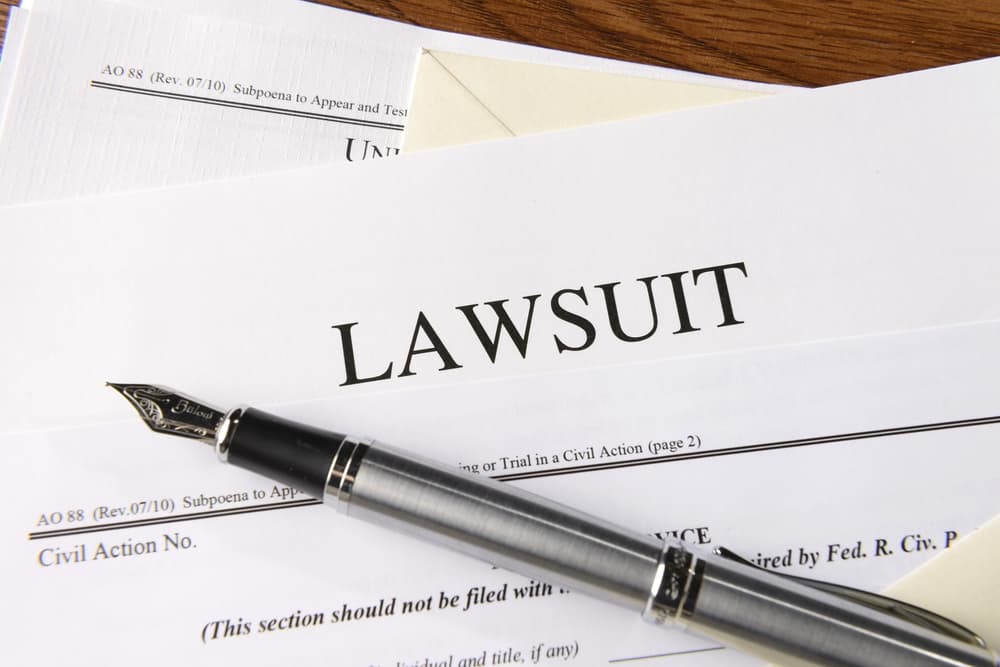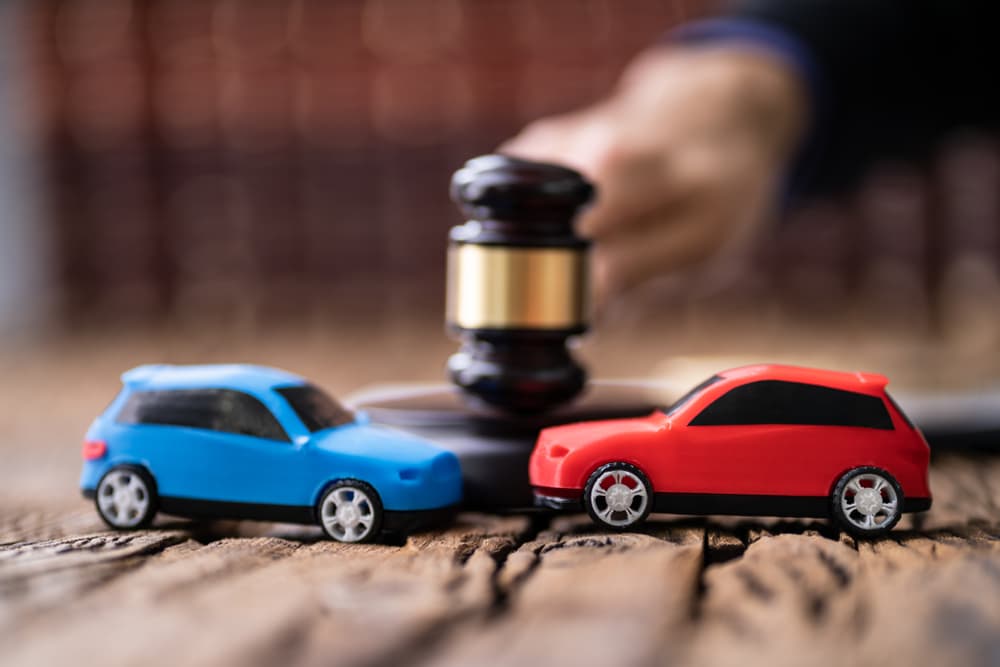There is a difference between filing a personal injury insurance claim and filing a lawsuit. Your personal injury lawyer will usually start by filing a claim as an initial step in seeking compensation after a car accident. Filing a claim primarily involves negotiations with the insurance company with the goal of reaching a settlement.
Filing a car accident lawsuit, on the other hand, is a formal legal action that involves the court system and a structured legal process that may lead to a trial if a settlement cannot be reached.
The choice between these two approaches depends on the accident and the willingness of parties to negotiate and settle. Most car accident claims settle, but if your case goes to court, you need an experienced Madison car accident attorney. They will represent you in court, present evidence, argue on your behalf, and protect your rights throughout the legal process.
Filing a Lawsuit

Filing a lawsuit is a formal legal process initiated in court against the at-fault party, called the defendant. Lawsuits are more common in complex cases with disputes over partial liability, severe injuries, or significant damages. The case goes before a judge and may involve a jury trial if not settled beforehand.
Lawsuits follow a structured legal process, including pleadings, discovery, motions, trial, and, potentially, appeals. A lawsuit can settle at almost any point in the process of the litigation.
To succeed in a personal injury lawsuit, you (the plaintiff) must demonstrate that the defendant is responsible for your injuries by proving their negligence or fault in connection with the accident. Once you establish liability, the court will assess the potential compensation you might receive in damages unless a settlement is reached prior to litigation.
Gathering Evidence
Evidence is the foundation of the car accident lawsuit. It establishes the facts surrounding the accident, establishes liability, and proves damages – the impact of the injuries on the injured party’s life.
An attorney with experience in personal injury cases plays a crucial role in gathering, organizing, and presenting this evidence effectively in court or during negotiations to seek compensation for the injured party.
Your lawyer will collect the following types of evidence to support your case:
- Accident report: Official accident reports prepared by law enforcement officers at the scene of the accident provide crucial details, including the date, time, location, and a preliminary assessment of fault.
- Witness statements: Statements from individuals who were present at the scene but not directly involved may provide valuable testimony regarding what they observed.
- Photographs and videos: Pictures and videos taken at the accident scene can document the positions of vehicles, road conditions, and traffic signals, and document skid marks, tire tracks, and debris on the road to help investigators recreate the sequence of events leading to the accident.
- Vehicle damage: Examination of the vehicles involved can reveal the extent of damage and potentially shed light on the point of impact and force of the collision.
- Medical records: Medical records of injuries sustained by all parties involved can establish a direct link between the accident and the injuries. The receipts and bills for medical treatment, therapy, medications, and other related expenses help quantify the financial impact of the injuries.
- Traffic violations: Any traffic citations issued at the scene, such as for speeding or running a red light, can indicate negligence or fault.
- Black box data: In modern vehicles, event data recorders (EDRs) or “black boxes” may contain data on vehicle speed, braking, and other critical factors leading up to the accident.
- Phone records: Phone records may be examined to determine if a driver was using a mobile device at the time of the accident, establishing negligence through distracted driving.
- Expert opinions: Accident reconstruction experts may be called upon to analyze the evidence and provide expert testimony regarding the cause of the accident.
- Losses: Documentation of lost income, including pay stubs and employer verification, establishes the economic losses caused by the accident. Personal journals, therapy records, and statements from friends and family can help demonstrate the emotional and psychological impact of the injuries and factor into personal injury claims for compensation for pain and suffering.
Initial Court Proceedings
When a lawsuit is filed, the initial court proceedings, often referred to as the pleadings phase, involve a series of formal documents and actions that set the stage for the legal dispute.
These proceedings can vary by jurisdiction, but the general steps typically include:
- Filing the complaint: The plaintiff files a document known as a “complaint” with the appropriate court. The complaint outlines the plaintiff’s claims, including the legal basis for the lawsuit, the facts of the case, and the relief sought, such as monetary damages or specific actions.
- Service of process: After the complaint is filed, the plaintiff must serve a copy of the complaint and a summons on the defendant. This notifies the defendant of the lawsuit and their legal obligations. Proper service is crucial to ensure the defendant has notice of the lawsuit and an opportunity to respond.
- Defendant’s response: In Wisconsin, a defendant generally has 20 days to respond to a complaint in a car accident lawsuit. This response typically takes the form of an “answer,” where the defendant addresses the allegations made in the plaintiff’s complaint and asserts any defenses they may have. If the defendant fails to respond within the specified timeframe, they risk a default judgment being entered against them, which could have serious legal consequences.
- Counterclaims and crossclaims: The defendant may file a counterclaim if they have claims against the plaintiff. Counterclaims are essentially lawsuits within the main lawsuit. If there are multiple parties involved, they may file crossclaims against each other, addressing disputes among themselves within the same lawsuit.
- Amendments to pleadings: Both parties may seek to amend their pleadings to clarify or modify their claims or defenses. However, court approval may be required in some cases.
- Motions to dismiss: The defendant may file a motion to dismiss, arguing that the plaintiff’s complaint does not state a valid legal claim or that there are other procedural defects. The court may rule on the motion to dismiss, which can lead to the dismissal of some or all of the claims.
The court may schedule conferences to discuss case management, discovery (evidence gathering), and potential settlement. During these conferences, the court and parties may set deadlines, exchange information, and explore settlement options.
The court may also issue a case management order outlining important dates and procedures, including deadlines for discovery, pre-trial motions, and trial preparation.
During the initial court proceedings, the plaintiff, defendant, and their attorneys may engage in pre-trial negotiations, which are informal discussions attempting to reach a mutually agreeable resolution without going to trial. These negotiations may be conducted through direct communication, mediated discussions, or by written correspondence.
Discovery Process
In a legal proceeding, such as a car accident lawsuit, both parties exchange information as part of the discovery process. This exchange of information helps each party better understand the opposing side’s case, gather evidence, and prepare for trial. It also promotes transparency and allows both parties to assess the strength of their claims and defenses. Discovery methods include interrogatories and depositions.
Interrogatories
Interrogatories are a set of written questions submitted by one party to the other party or parties involved in the lawsuit to elicit specific information, facts, and details about the case. They can cover a wide range of topics relevant to the lawsuit.
The party receiving the interrogatories must provide complete, truthful written responses under oath. You must meet a specific deadline for submission. Interrogatories can ask about the party’s version of events, witnesses, evidence, insurance coverage, and other relevant matters.
Depositions
Depositions involve oral testimony given by witnesses, including parties involved in the lawsuit, under oath. A court reporter records the proceedings. Depositions serve several purposes, including obtaining sworn statements, clarifying or challenging testimony, and assessing a witness’s credibility.
Attorneys for both parties are present during depositions and can ask questions. The witness is under oath and obligated to answer truthfully. After the deposition, a court reporter produces a written transcript you can use as evidence in court.
The discovery process takes place under oath, and providing false or misleading information is perjury, which is a serious criminal offense. This means that lying during discovery can lead to criminal charges, fines, and potential imprisonment.
Truthfulness is also an ethical obligation. Truthfulness enhances your credibility as a party or witness. If you are dishonest during discovery, it can severely undermine your credibility with opposing counsel, the judge, and, if the case goes to trial, with the jury. A lack of credibility can significantly harm your case.
Pre-Trial Motions
In the context of a lawsuit, a motion is a formal request made by one of the parties involved in the case to the court. It is a written or oral application asking the court to take a specific action or make a particular ruling on a legal issue.
Two of the most familiar motions are:
- Motion to dismiss: This motion requests the court to dismiss some or all of the claims in the lawsuit. It may be filed if the defendant believes the plaintiff’s complaint lacks legal merit, fails to state a valid claim, or has procedural deficiencies.
- Motion for summary judgment: This motion asks the court to rule in favor of one party without a trial based on the undisputed facts and applicable law. It asserts that there are no genuine issues of material fact, and the court should decide the case as a matter of law.
However, motions serve a wide variety of purposes, including:
- Seeking a ruling, which is asking the court to make a decision on specific matters related to the case on issues of law, procedure, or evidence;
- Resolving disputes;
- Changing court orders;
- Challenging legal issues like the validity of a complaint, sufficiency of evidence, or the application of a particular law to the case;
- Controlling the trial process;
- Seeking relief such as injunctive relief, monetary sanctions, or a dismissal of the case;
- Requesting postponements; and
- Protecting rights.
The court reviews these motions, considers the arguments presented by both parties, and issues rulings that can significantly impact the trajectory of the case, potentially leading to its resolution, affecting trial strategy, or shaping the scope of the trial itself.
Trial
The trial process is a structured and formal procedure designed to resolve legal disputes based on evidence, legal arguments, and the principles of justice. There are several key stages, each serving a specific purpose.
Primary among these are:
- Jury selection (voir dire): The trial begins with jury selection, a process called voir dire. Attorneys for both sides and the judge question prospective jurors with the goal of choosing an impartial and unbiased jury that can fairly evaluate the evidence and render a verdict based on the law.
- Opening statements: After the jury is selected and seated, the trial officially begins with opening statements where each party’s attorney outlines their case’s key points and previews the evidence they intend to present. Opening statements provide an overview of the case and help jurors understand the context and issues involved.
- Presentation of evidence: The core of the trial involves the presentation of evidence, which includes witness testimony, documents, exhibits, and other relevant information. Both the plaintiff and the defendant can present their evidence and call witnesses to support their claims and defenses.
- Rebuttal and surrebuttal: After both parties present their cases, they may have the opportunity for rebuttal and surrebuttal. This involves offering additional evidence or witnesses to respond to points made by the opposing side.
- Closing arguments: Each attorney delivers a closing argument to summarize their case, reemphasize key points, and persuade the jury to adopt their perspective. Attorneys often highlight the evidence presented during the trial and explain how it supports their legal arguments.
- Jury instructions: Before the jury begins deliberations, the judge provides them with instructions regarding the applicable law, legal standards, and the elements the plaintiff must prove to win the case.
- Jury deliberations: The jury retires to a deliberation room to discuss the case and reach a verdict. Jury deliberations are confidential, and jurors must reach a unanimous decision (in most cases) to render a verdict.
Before the trial begins or at almost any point during the course of the trial, the plaintiff and defendant and their lawyers may reach a settlement agreement to resolve the case.
Verdict and Judgment
Once the jury reaches a verdict, they return to the courtroom, and the verdict is announced. The judge or a court clerk typically reads the verdict aloud. The verdict can result in a finding in favor of the plaintiff, the defendant, or a combination of both.
After the trial, there may be post-trial motions, such as motions for a new trial or judgment notwithstanding the verdict. If either party dislikes the trial’s outcome, they may file an appeal to a higher court.
If there is no appeal or if the appeal is unsuccessful, the court enters a judgment based on the trial’s outcome. The judgment specifies the legal obligations of the parties. You may take enforcement measures to carry out the judgment, such as the collection of monetary awards.
The trial is a structured and formal procedure to resolve legal disputes based on evidence, legal arguments, and the principles of justice. It follows strict legal rules and procedures to ensure fairness and impartiality.
Contact a Car Accident Lawyer at Pemberton Personal Injury Law Firm Today

After a car accident in Wisconsin, you don’t have to navigate the legal complexities alone. Our legal team has handled hundreds of car accidents, and we know what to look for to establish liability and bring a claim on your behalf.
If the insurance company refuses to settle, the experienced personal injury attorneys from Pemberton Personal Injury Law Firm can file a lawsuit and advocate for your rights in court.
Our firm has the experience and knowledge to help you get the compensation you deserve. With offices in Baraboo and Madison, we represent clients throughout Wisconsin and make it our priority to get to know our clients and their cases personally.
Arrange for a consultation with one of our car accident lawyers by calling (608) 448-6242 or filling out our online contact form. There is no cost or obligation when you meet with us. We are prepared to go the distance to get you the compensation you deserve.
 Calls Answered 24/7
Calls Answered 24/7









